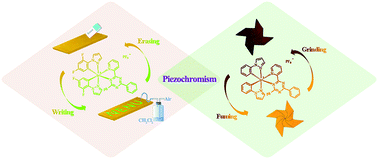New cationic Ir(iii) complexes without “any soft substituents”: aggregation-induced emission and piezochromic luminescence†
Abstract
Two new aggregation-induced emission (AIE)-active cationic Ir(III) complexes with relatively rigid ligands have been rationally designed and synthesized, exhibiting excellent piezochromic luminescence (PCL) properties. In the solid state, their emission colours are tunable by a grinding–fuming process with high contrast and good reversibility, clearly visible to the naked eye. Powder X-ray diffraction studies prove that the observed piezochromic behaviour originates from the phase transition between the crystalline state and amorphous state upon mechanical stimulation. Compared with complex 2, the emission of complex 1 in the solid state is blue-shifted by 49 nm because of the electron-withdrawing property of fluorine substituents. Unlike many known cationic Ir(III) complexes with imine units or dendrimer-like or flexible alkyl chain substituents, here, AIE and PCL properties have been realized simultaneously by constructing cationic Ir(III) complexes without “any soft substituents” in their cyclometalated and ancillary ligands. Reproducible phosphorescence data recording and chemical monitoring devices have been constructed using complexes 1 and 2 as the active materials, respectively.

- This article is part of the themed collection: Aggregation-Induced Emission with Bin Liu and Ben Zhong Tang


 Please wait while we load your content...
Please wait while we load your content...